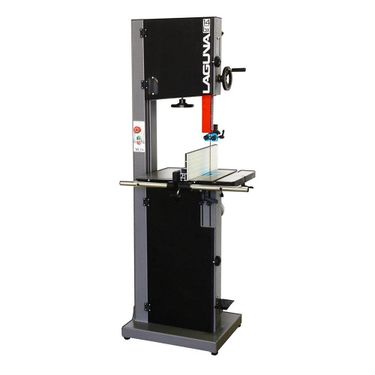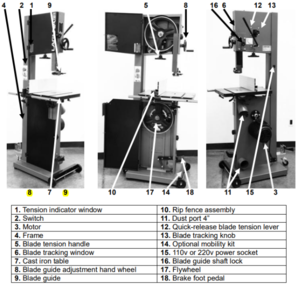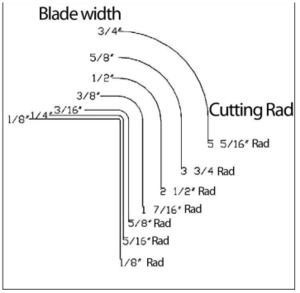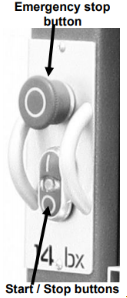Difference between revisions of "Vertical Wood Bandsaw"
| Line 50: | Line 50: | ||
====General Procedure==== | ====General Procedure==== | ||
| − | # Make sure the blade | + | # Make sure the blade guides and fence are in place. These are meant to help your cut, so it is crucial that these are in place. |
| − | ## Instructions on adjusting can be found in the manual | + | ## Instructions on adjusting can be found in the manual, but they should be fine by default. The ace should take care of such issues. |
| − | ### Blade | + | ### Blade guides (p. 33-34) |
### Fence (p. 35-37) | ### Fence (p. 35-37) | ||
# Adjust the upper blade guard so that it is just clearing the material being cut | # Adjust the upper blade guard so that it is just clearing the material being cut | ||
| − | # Make sure that the cutting teeth are facing down | + | # Make sure that the cutting teeth are facing down since the blade moves downward. Otherwise, it will not cut. |
# Make sure that the blade has been properly tensioned (blade doesn’t have slack) and tracked (blade moves evenly and consistently as the wheels turn, doesn’t wander back and forth) | # Make sure that the blade has been properly tensioned (blade doesn’t have slack) and tracked (blade moves evenly and consistently as the wheels turn, doesn’t wander back and forth) | ||
## Instructions on tensioning (p. 30) and tracking (p. 29) can be found in the manual | ## Instructions on tensioning (p. 30) and tracking (p. 29) can be found in the manual | ||
# Make sure the proper size and type of blade is in use | # Make sure the proper size and type of blade is in use | ||
| − | ## | + | ##[[File:...woodVerticalBandsawKerf.png|none|thumb]] |
## Blade help is in the manual (p. 38-42) | ## Blade help is in the manual (p. 38-42) | ||
| − | # Turn the saw on | + | # Turn the saw on. ‘1’ turns on, ‘0’ turns off. [[File:...woodVerticalBandsawOnOff.png|none|thumb]] |
| − | |||
# Hold the workpiece firmly against the table, flat side down | # Hold the workpiece firmly against the table, flat side down | ||
# Push material into blade at a moderate pace, using a push stick if necessary at the end of the cut | # Push material into blade at a moderate pace, using a push stick if necessary at the end of the cut | ||
# Turn the machine off once the cut is complete | # Turn the machine off once the cut is complete | ||
| − | # Remove the workpiece | + | # Remove the workpiece and reset the space. |
==Safety== | ==Safety== | ||
Revision as of 16:04, 22 August 2019
Make: Laguna
Model: mband 14BX220-250
Ace: Needed (Makerhub@georgefox.edu).
Location: Wood Shop
Description
The bandsaw is generally defined as a saw blade in the form of an endless steel band that rotates around two or more wheels. This blade is a continuous metal band with teeth on one side. As the wheels rotate, so does the band, which creates the continuous sawing action. Because the direction of the blade is always downward toward the table, there is little danger (except for special cuts) that the wood will be thrown back at the operator, which is called a kickback. For safety reasons many woodworkers prefer the bandsaw especially when cutting small pieces. The unique feature of the bandsaw is that the workpiece can be rotated around the blade creating a curve. It is the tool most often used when curves have to be cut in wood. Because the bandsaw blade is fairly thin, it can cut thick stock with a minimum of horsepower. For this reason the bandsaw is often used when valuable pieces of wood are made into a thin piece of veneer.
Although the bandsaw is usually associated with cutting curves, a variety of straight cuts are easily made with the saw. In fact, it is often used to rip wood because it is much safer than a radial arm saw and also has a smaller saw cut, so it wastes less wood. This becomes very important when using expensive wood where waste must be kept to a minimum. The cut is safer because the force of the cut is straight down on the table; the work cannot be pulled back or kicked back, which sometimes happens with table or radial arm saws. The bandsaw can also cut very thick stock, which the radial arm, or table saw cannot do. The disadvantage of cutting with the bandsaw is that the surface finish of the cut is not as good as with the table or radial arm saw.
Documentation
Terminology
Training
Overview
Insert Text
Demonstration
To show a complete knowledge of the Wood Vertical Bandsaw, the student will cut out a curved shape using scrap wood.
General Procedure
- Make sure the blade guides and fence are in place. These are meant to help your cut, so it is crucial that these are in place.
- Instructions on adjusting can be found in the manual, but they should be fine by default. The ace should take care of such issues.
- Blade guides (p. 33-34)
- Fence (p. 35-37)
- Instructions on adjusting can be found in the manual, but they should be fine by default. The ace should take care of such issues.
- Adjust the upper blade guard so that it is just clearing the material being cut
- Make sure that the cutting teeth are facing down since the blade moves downward. Otherwise, it will not cut.
- Make sure that the blade has been properly tensioned (blade doesn’t have slack) and tracked (blade moves evenly and consistently as the wheels turn, doesn’t wander back and forth)
- Instructions on tensioning (p. 30) and tracking (p. 29) can be found in the manual
- Make sure the proper size and type of blade is in use
- Blade help is in the manual (p. 38-42)
- Turn the saw on. ‘1’ turns on, ‘0’ turns off.
- Hold the workpiece firmly against the table, flat side down
- Push material into blade at a moderate pace, using a push stick if necessary at the end of the cut
- Turn the machine off once the cut is complete
- Remove the workpiece and reset the space.
Safety
Insert text
Certification
Troubleshooting
Maintenance
General maintenance
Little maintenance is needed to upkeep the Wood Vertical Bandsaw. Refer to the table below for specific tasks.
Specific Maintenance Tasks
| Maintenance Procedure | Frequency | Done By |
|---|---|---|
| General Cleaning | After each use | Student |
| Blade Change | When Dull | Ace |
| Rotate back blade guard 15 degrees | Every 8 hours of use | Ace |



